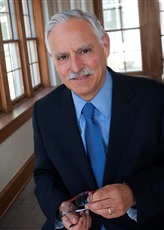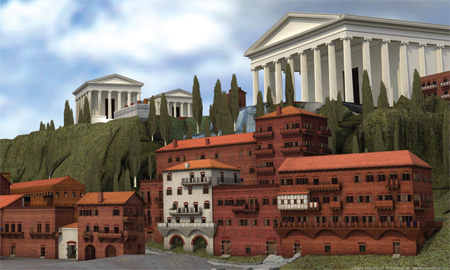Home » Events » Virtual Archaeologist Bernard Frischer to Deliver Goldberg Lecture on October 11
Virtual Archaeologist Bernard Frischer to Deliver Goldberg Lecture on October 11
Posted by vrcvanderbilt on Tuesday, October 2, 2018 in Events, HART, Lectures, News, Vanderbilt University, VRC.
 Bernard Frischer, a leading virtual archaeologist and director of the Virtual Heritage Program and professor of informatics at Indiana University, will deliver the Norman L. and Roselea J. Goldberg Lecture on Thursday, October 11, at 4:10 pm in 203 Cohen Memorial Hall on the Peabody campus. Frischer, founding director of the Virtual World Heritage Laboratory, will bring ancient Rome back to life in his lecture, “Adventures in Digital Heritage,” with a reception to follow in the atrium.
Bernard Frischer, a leading virtual archaeologist and director of the Virtual Heritage Program and professor of informatics at Indiana University, will deliver the Norman L. and Roselea J. Goldberg Lecture on Thursday, October 11, at 4:10 pm in 203 Cohen Memorial Hall on the Peabody campus. Frischer, founding director of the Virtual World Heritage Laboratory, will bring ancient Rome back to life in his lecture, “Adventures in Digital Heritage,” with a reception to follow in the atrium.
The Rome Reborn project, directed by Frischer, is an international initiative, launched in 1996, to create an interactive 3D reconstruction of the ancient city of Rome within the Aurelian Walls as it appeared in 320 CE—the peak of its ancient development, shortly before the Imperial capital was moved to Constantinople. After 22 years of hard work by an interdisciplinary team, the model was completed in August and made available to scholars and the general public through the VR publisher Flyover Zone Productions.
Rome Reborn offers bird’s-eye and ground views of the Eternal City with red-roofed buildings and massive marble statues and temples. “The Rome Reborn project is the continuation of five centuries of research by scholars, architects and artists since the Renaissance who have attempted to restore the ruins of the ancient city with words, maps and images,” said Frischer, who is the founding editor of Digital Applications in Archaeology and Cultural Heritage, an on-line, peer-reviewed journal in which scholars can publish 3D digital models of the world’s cultural heritage sites, monuments, and paleoanthropological remains.
His lecture will explore Rome Reborn as a tool of discovery in Roman topography and urban history. Until now, Roman topographers have approached the Imperial  city by concentrating on a specific monument or the projects of an individual emperor or dynasty. Now, thanks to the availability of this interactive city model, we can look at the city in more holistic, synchronic, and dynamic ways. In fact, Rome Reborn allows us to make observations and to run experiments in ways previously impossible without time-travel. In his lecture Frischer will include case studies on the alignments of monuments, dynamic viewshed analysis, and evidence of urban planning and land use across the entire cityscape.
city by concentrating on a specific monument or the projects of an individual emperor or dynasty. Now, thanks to the availability of this interactive city model, we can look at the city in more holistic, synchronic, and dynamic ways. In fact, Rome Reborn allows us to make observations and to run experiments in ways previously impossible without time-travel. In his lecture Frischer will include case studies on the alignments of monuments, dynamic viewshed analysis, and evidence of urban planning and land use across the entire cityscape.
Free and open to the public, the Goldberg Lecture is sponsored by the Department of History of Art, with support from the Vanderbilt University Center for Digital Humanities, the Archaeological Institute of America, and the Conservancy for the Parthenon and Centennial Park. Parking is available in all non-reserved spaces in Lot 95 near Cohen Hall on the Peabody campus.
§
Prior to his Goldberg lecture on October 11, Frischer will present “Rome Reborn VR: A Demonstration of Recently Published Applications,” a hands-on workshop (with lunch) held from 12:30 to 2 pm in the History of Art’s Visual Resources Center, 134 Cohen Memorial Hall. Participants will be able to use the Oculus Go headset to try out the project’s recently published applications, including “The Roman Forum” and “A Flight over the Ancient City.” Sponsors are the Department of History of Art, Digital Humanities Center, and Digital Cultural Heritage Research Cluster. Everyone is invited to come by the VRC and have lunch and explore ancient Rome with us!

©2026 Vanderbilt University ·
Site Development: University Web Communications